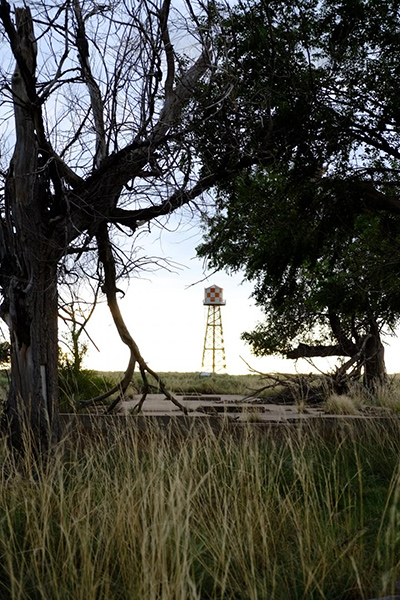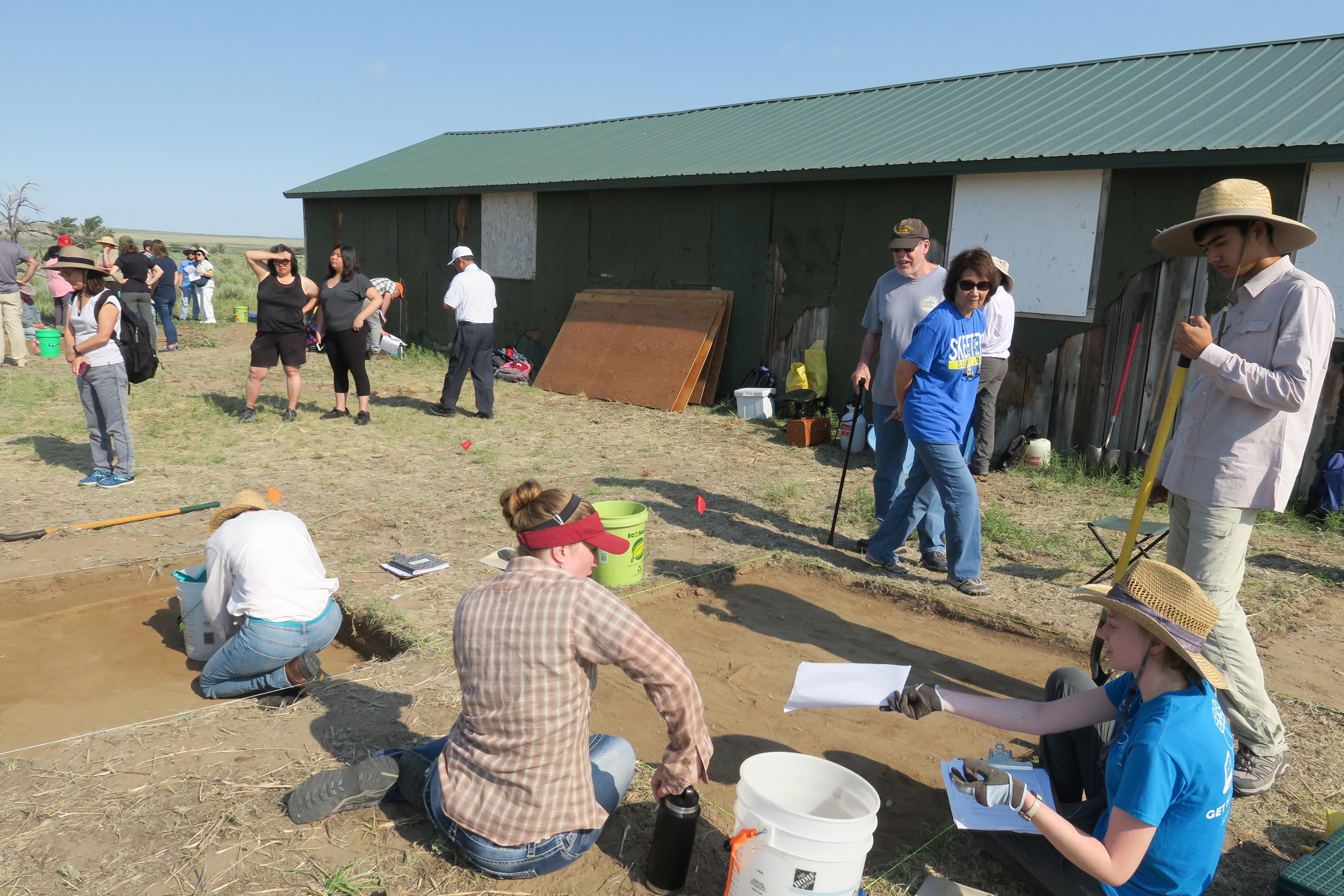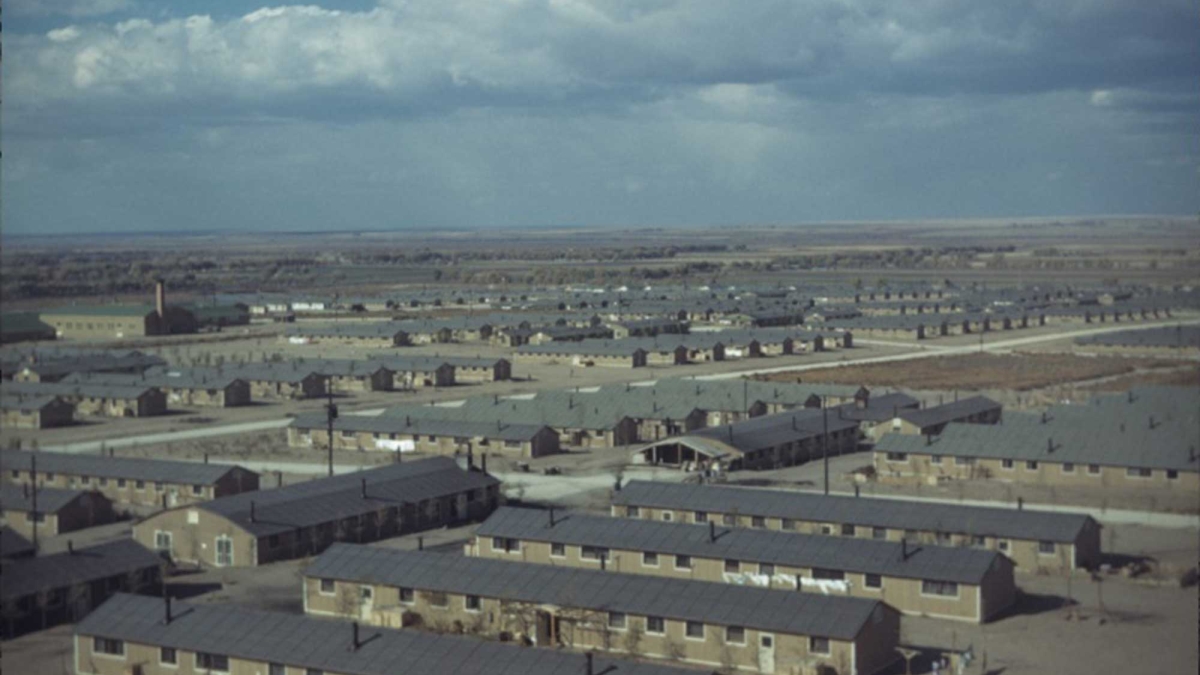During World War II, the U.S. government forced around 120,000 Japanese Americans living on the West Coast out of their homes and into 10 different family incarceration centers.
Nearly 80 years later, those detainees have left a complex legacy — one that warns against racism and breakdowns in democracy, but also speaks to solidarity during times of oppression and the core of what it means to form a community.

The remains of an Amache barrack foundation and a historic water tower behind. Photo courtesy of Greg Kitajima/University of Denver Amache Project
April Kamp-Whittaker, an archaeology PhD student in the School of Human Evolution and Social Change, has dedicated herself to researching this unique moment in Japanese American history and discovering the lessons it holds for us today.
She specifically focuses on the Granada Relocation Center in Colorado, which goes by the colloquial name of Camp Amache. She sees the space as a giant urban center, and it was in fact one of the largest cities in the state at the time, with a population of about 9,000.
Last spring, Kamp-Whittaker received a grant from the Philanthropic Educational Organization to further her doctoral research, which examines how people from all over the West Coast and parts of Arizona came together in these difficult circumstances to form communities and create social spaces.
To study this, she looks at both the archaeological evidence of ways that the internees customized their neighborhoods as well as archival records, such as newspapers, that document social events.
Building community and hope
Amache was arranged into blocks that functioned much like neighborhoods, and each neighborhood had public spaces including a recreation hall. The internees used some as nursery schools or Boy Scout troop headquarters, but they also served as places for unstructured community events like art classes and dances.

ASU archaeology PhD student April Kamp-Whittaker (center) and others excavate at a garden by a recreation hall. Photo courtesy of the University of Denver Amache Project
Kamp-Whittaker also finds archaeological evidence of sports, like a baseball field’s backstop and a sumo ring, in addition to records of basketball, football, table tennis and jujitsu. Internees built other structures as well, such as playgrounds, private and communal gardens, and even a traditional Japanese bath.
“There were both American and Japanese cultural activities going on,” she said.
A newspaper that the internees wrote and published for themselves gives Kamp-Whittaker additional context for these archaeological finds by documenting social club events and sports game outcomes. These allow her to track where events took place and who people were socializing with, re-creating the social activities at Amache.
Kamp-Whittaker is careful to emphasize that her study of community — which often has positive associations — is not meant to downplay the dark side of this moment in history. Rather, she seeks to explore the full experiences of those incarcerated.
“Incarceration is complicated to talk about because it was terrible and unconstitutional, but people also had life events there. They met their significant other and got married, they graduated from high school, they celebrated their fifth birthday,” she said. “Imagine your world was taken out of its normal context, shifted to a new context and forced to continue.”
These uniquely trying circumstances, however, created a close-knit community that still thrives today.
Connections that last
Multiple groups are currently involved in preserving the site and history of Amache — the researchers, the former internees, the descendants of those who were incarcerated and even a preservation organization from the local high school in Granada.
“It’s this fascinating, interwoven community of people. It’s really neat because we have one goal, and that’s to interpret and preserve this moment in history and the experiences of people,” Kamp-Whittaker said.

Kamp-Whittaker displays an excavated jar lid with label still visible at a community open house outreach event. Photo courtesy of Greg Kitajima/University of Denver Amache Project
The Amache community’s involvement, however, also brings one of her project’s greatest challenges. Very few archaeologists are able to interact with people who lived at their site during the time period they study. Because Kamp-Whittaker is one of those rare cases, she has to balance the larger story of Amache with staying true to the stories of individuals.
“Recognizing and talking about their lives in a way that answers questions but honors and respects all these individual experiences is really hard,” she said.
She herself helps pass on those experiences by lending her expertise and findings to the creation of public presentations, exhibits and even K-12 curriculum.
The University of Denver Amache Project, of which her work is a part, also hosts a multigenerational archaeological field school at the site every other year. Attendees include the local high school preservation organization, an intern who is part of a program for the descendant community, college students and volunteers who are either descendants or were at Amache themselves.
These interactions between people, Kamp-Whittaker says, create a truly unique learning environment.
Strengthening society
Kamp-Whittaker sees her research as important on two fronts, the first being that we need to understand how communities work in order to understand ourselves.
By learning about how the people incarcerated at Amache built communal spaces on the site and interacted with each other, we gain insight into how humans make the transition from people who live near each other to people who know and care for each other.
“There’s been a running discourse about whether communities are falling apart, especially in urban centers. We don’t talk to our neighbors anymore,” she said. “Are we part of our neighborhoods and local-based communities, or are we not? Is globalization changing what a community is?”
Her research also highlights a catastrophic moment in American history that people don’t often talk about.
“When we hear a lot of the same rhetoric (that was used toward Japanese Americans during World War II) being used about immigrants and racialized and ethnic minorities in this country, it should make us want to study this history even more, because it shows how important it is to continue talking about this,” she said. “If we can build really strong communities, then we strengthen our society.”
Top photo: A photo of Camp Amache taken circa late 1942. Photo courtesy of the Amache Preservation Society
More Arts, humanities and education
ASU FIDM students to see their designs on the runway at Uncertainty Fashion Showcase
Nola Hill is perfecting every stitch of her fashion design collection, which she started conceptualizing last summer.She is among 30 ASU FIDM fashion design students who have been working late into…

ASU+GSV Summit brings experts together to discuss innovation in education
This week, Arizona State University President Michael Crow and other university leadership joined education and learning experts from around the globe at the ASU+GSV education technology summit in…

ASU professor's project helps students learn complex topics
One of Arizona State University’s top professors is using her signature research project to improve how college students learn science, technology, engineering, math and medicine.Micki Chi, who is a…


